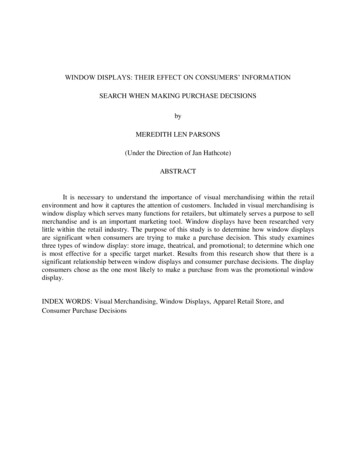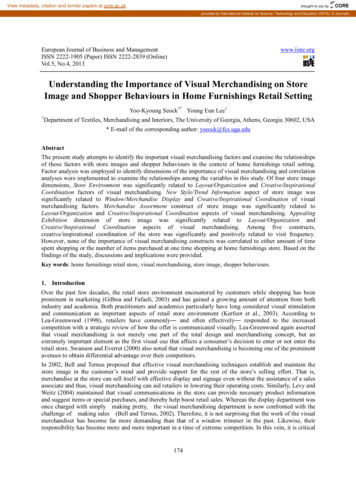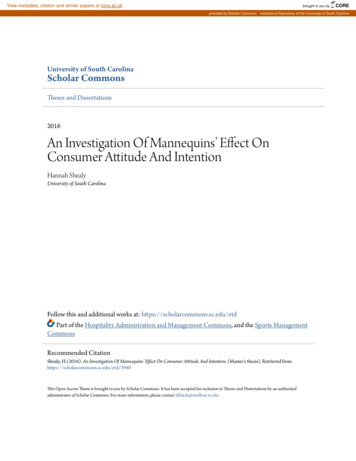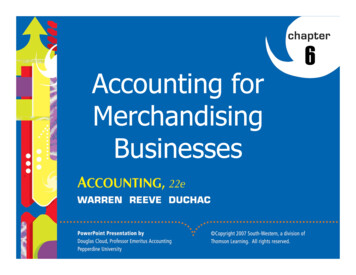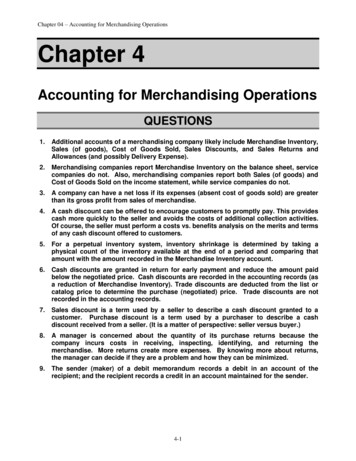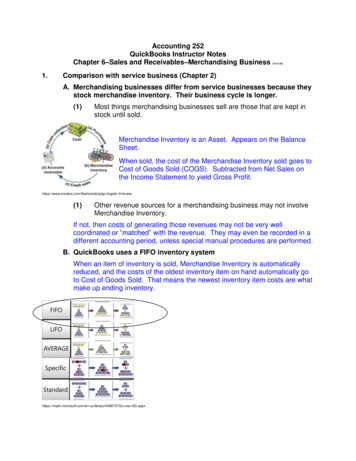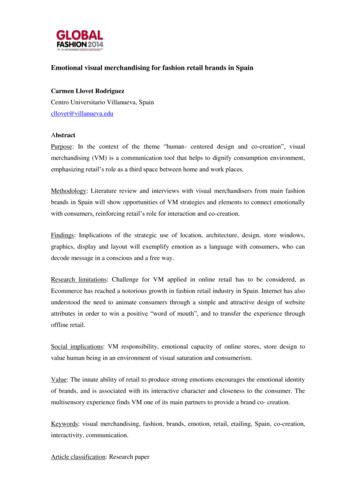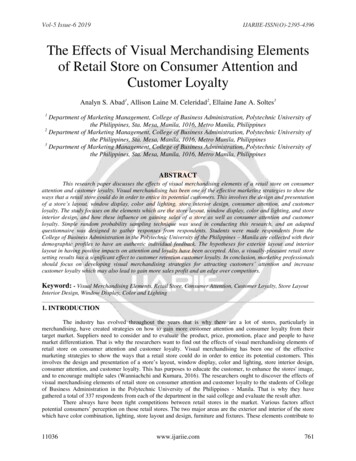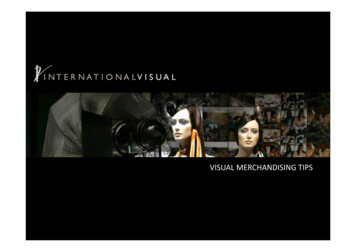
Transcription
VISUAL MERCHANDISING TIPS
Founded in 2007 based in Dundee Owned and managed by Lynda Murray and Phill Hill Specialists in Visual Merchandising , displays and store environments One Stop Shop – Design, implementation, consultancy and training Variety of clients from High Street brands to small independents both UK and abroad
Our ClientsHigh Street StoresNon High StreetInternationalMarks and SpencersJohn LewisBootsThomas PinkAllied CarpetsL’OrealEmporio HomeCharles TyrwhittL K BennettG StarTop ShopPringleNew LookFat FaceVariety of independentsRochdale CouncilV&AHopetoun House EstatesCairnie Fruit FarmTayside AviationShackleton TechnologiesTony G designYMCAScottish Antiques CentreSarah Lawrence - GreeceHertie - GermanyAlganhim Industries - KuwaitHilco – ViennaBogazzi Training Company - Istanbul
Introductions
What is Visual Merchandising?Successful Visual Merchandisinginvolves;Good Store LayoutsUsing the Right Merchandising stylefor the product typeIncorporating appropriate propsand displays to support the productAdding the correct signage andgraphics to communicate to thecustomer
Key ComponentsLayoutsMerchandisingDisplayGraphicsSpace PlanningSegmentationFixture LayoutDraw a planCreate LayoutChoosing theright style foryour productsAdding InterestAdding CharacterSupporting the brandAdd interestAdd CharacterSupport the brandCommunicateSell
LayoutsNorthWestEastSouth1. Draw a plan of your store2. Mark on all the fixed items ‐doors, fixtures/fittings etc3. Look for the most visualpoints in the store – theseare where you position yourkey statements/points ofinterest. This could be abranded fixture, a display ora graphic/signWe recommend using theNorth, South, East Westprinciple to get interestthroughout the store
Layouts Cont’dCategory CCategory ACategory B3. Decide where your maincategories of products aregoing ensuring the size ofthe space given is relative tothe sales. i.e If you expect totake 50% of your sales fromcategory A you should planto give it 50% of the spaceand so on.Also check that the fixedfittings in that area areappropriate for the producttype.
Layout cont’d4. Then draw on the fixturestrying to maintain a balanced,symmetrical plan as far aspossible5.Use walls to get volume ofproduct out with shelving or rails.Keep floors lighter ensuring thereis sufficient walkway space.Minimum of 1metre even in thesmallest shop but ideally1200mm.6. Keep lower fixtures to the frontand work up in height as you gobackwards – to aid visibilitythrough the store
Layout cont’dNorthCategory CWestEastSouthCategory ACategory BYour layout planningstage is now completeand has all thecomponents marked onthe plan. You can nowphysically begin to createyour layout
Once you have positioned all your fixtures you are ready to visually merchandise the shop.This requires an understanding of your brand, your customer, your product range and how tosegment it and present it to its best advantage to drive sales from your customers
Merchandising PrinciplesSTOCK HOLDINGMenswearWomenswearKidsThe basic principles of merchandising start with product segmentation. Productsegmentation brings order and simplicity both to the way stock is bought and the way youpresent it. In our example we are using a fashion store but the method works for all producttypes. Start by breaking your stockholding into the big categories.
Merchandising PrinciplesOnce you have divided your products into category ,then sub divide into types of products. Thiscould be by brand, by garment type, by customer profile[age for kids] etcSTOCK ssoriesBrand 1Brand s
Merchandising PrinciplesLastly, for each product type decide whether it is best for your store and your customer topresent the product by brand, by price, by colour, by size or by finish/fabric etc. Make yourdecision for the right reasons. Will it sell more? Make it easier to shop?WomenswearBrand 1Brand 2OuterwearIn co‐ordinated storiesas it is bought to lookthat way andencourage add onsalesIn styles because it is ajeans brand andcustomers like to shopby style – boot leg, slimetc then bycolour/fabricBy type/style. E.G.All raincoatstogether in style[short,long etc]then by colourAccessoriesBy colour as customersselect their accessories tomatch outfits and somewill be merchandised withthe fashion range toencourage add on sales
Merchandising PrinciplesBrand 1BrandingGraphicBrand 2OuterwearCash DeskAccessoriesSeasonalDisplayNow you can go back toyour layout and plotwhere each of theseranges will fit best andlook best.
Merchandising TechniquesThere are several techniques used to deliver great merchandising solutions;Creating themes/storiesCo-ordinationBlocking by style/typeUsing colour [complementary or contrasting]Symmetry and balanceRepetitionTriangular groupingOver the next set of slides we will show great examples of each method
Co-ordinated Colour StoryNote how the hard and softproducts are alternated acrossthe shelvesAlso note how each shelf hasbeen sub divided into 3 smallerblocks to create interest to thedisplay. This is a valuable visualtechniqueDark shades mix withcomplementary light shadesThe whole theme worksbecause customers can buy aco-ordinated look
Co-ordinated Colour StoryThis is a strong story usingred,white dining products withclear glassThe fixtures have multiplelayers/heights using a table,cubes and risers. This helpsto create a strong statementas the product fills the spacewell on all levelsThe patterned product is welldispersed and the white andred evenly distributed to givea balanced look
Co-ordinated Colour StoryIn this story the patterned china isinterspersed with co-ordinating plainglassThe setting/fixture in this instance is adining table and bench. The top of thetable has simple cubes set on top togive a variety of heights.Note how the tallest cube is in thecentre, working down to lower cubestowards the front and side. This is calleda triangular grouping which alwaysworks well.Also note how the table and bench aresub divided into small sections to houseeach product type. i.e the bench has 5individual squares of product neatlyoccupying its own square of space. Thisis called blocking.
Product StoryThis time the theme/story isbased on eggs.The fixtures are a mixture ofold/vintage tables and farmcrates. Note how theconfiguration of fixtures is ina tiered formation – high atthe back, tumbling to low atthe front.Products are blocked withintheir own squares or rows onthe tables/cratesFresh eggs mix with egg/henaccessories to create atheme. Straw is added tosupport the look
Table displays work well for fashion too. This display makes a great statement.Tables used in two heights with further surfaces created with vintage suitcases. Adressed mannequin promotes the products on sale on the table.
Blocked DenimJeans are blocked by style inpiles on shelves. Each pile is insize order. One of each stylehung from butchers hooks on arail above the shelves to easeselectionAdjacent to this we used denimjackets and jeans in a coordinated story. The hangerdisplay on the end of the fixtureshowing how to pull the looktogether. This aids multiple salesFinal touches – accessories areadded. Belts hang on a stainlesssteel t-bar on one fixture andscarves are folded in a tray onthe base of another – allencouraging linked sales.
Only merchandise up to a height that customers can reach. The area above that shouldbe treated as display. This is a good example of how you can use that space forsupporting displays. Use products from the same area together with appropriate props.
In fashion shops we recommend using mannequins inside the store as well as in yourwindows. They sell the product as they bring it to life. Sitting mannequins are a good optionfor table groups.
Repetition displayWhen using piles of folded knitwear inyour displays ensure you usecardboard or tissue paper to achieveneat folded edges as shown here.Note how jewellery is then added tothe piles in a uniform fashion. This iscalled the repetition techniqueTip – to get all the garments the samewidth use a clipboard as a template tofold around.
Supporting display props shouldreflect the lifestyle of the customerthe store wants to attract. Theymust support not detract from theproduct on sale
Mix props with products to evokethe right look. Note how theframes provide a backdrop to thedisplay and set the scene thenproducts are displayed in atriangular grouping on theshelves
Product blockingIn this example the vases have been blocked together as adepartment. They are sub divided by colour. Most are neutral but ineach bay one highlight colour is used to provide a bit of interest.
Mirror Imaging & Triangular FormationHere you can see how mirror imaging of products can create a very effective display. Look atthe top of the table grouping and you will see that each product is mirror imaged i.e the sameproduct are on the left and right sides of the table. They are also ranged in height – highest inthe centre and lowest to the outside edge in a triangular formation
Co-ordinationThis is a co-ordinated story usingwhite kitchenware, glass storageand woodware. The effect issuperb.It often pays to keep things simple
BlockingSometimes it pays to block items by type and show the customer the fullrange/choice on offer. In this case the offer is dining chairs simply rowed up incubes. The display is given a ‘Mondrian’ look by adding coloured card behindthe cubes – this strengthens the look and supports the colours on offer
Colour BlockingBedlinen looks greatblocked by colour.Customers tend to choosebedlinen by colour and liketo see a co-ordinated look.Have as many display bedsas you can because theysell the merchandise!
The segmentation rulesapply to all types ofproduct – evenmagazines. Seen here ina small holiday resortstore – sub divided intomen’s titles, women’stitles and then kids.
Co-ordinationA BBQ story made up of charcoal, instant BBQ’s, tongs etc together withcamping seats, rugs and flasks. This is a standard table made to look morerustic with the addition of crates and baskets as props
Central focal pointTry to create a feature point on each wall. When you have a ,long run of the samefixture it pays to break it up by creating a strong central feature. In this example asection of crates is used to house red wine and beers. It looks amazing!
Triangular FormationBefore you begin to merchandise, ensureyour fixtures provide an interestingplatform for your product.The fixture should support, not overpower the product. The product is KING.If you want to create interesting displaysthat requires a variety of surfaces. [Flatdisplays generally look dull and boring]Use triangular grouping techniques togain height and tumble the displaytowards the customer.This example shows crates creating thediffering heights. A more modernalternative are MDF cubes or acrylicboxes. Opt for a style to suit your storedesign/customer profile
BlockingSometimes it is better toblock items rather than coordinate them as it helpsthe customer select.Denim is a good example.Customers want to shop bystyle and finish so youshould merchandise thatway.
Focal PointsWhen creating a focal point youneed to consider the look youneed to achieve to attract thecustomer you want.If it bis fashion ideally you need toinclude mannequins or bustforms. Then support the displaywith appropriate props.In this instance the props are oildrums – pretty clean ones as thisproduct is not distressed denim.If you have key brands, makesure their signage is prominent –these brands help sell the product.
Focal PointsA focal point attracts customers to an area, supports the product on offer and sells the outfit/s.Ideally position centrally on the wall. In this example we used a couple of strips of wallpaper inthe centre of the wall to create a backdrop for the display and positioned a mannequin in frontof it. We also used framed car prints at high level. All the supporting material/propssupporting the streamlined, suiting look.
Branding/SignageThe signage in this store wascreated cheaply by painting asimple grey band at the top ofthe wall and then sticking on avinyl decal [sticker] of thebrand logo. The effect is veryprofessional
VISUAL MERCHANDISING TIPS
In our example we are using a fashion store but the method works for all product types. Start by breaking your stockholding into the big categories. STOCK HOLDING. Menswear. Womenswear. Kids. Merchandising Principles Once you have divided your products into category ,then sub divide into types of products. .
